Fraudulent Telegram and WhatsApp groups
Please beware of fraudulent Telegram and WhatsApp groups impersonating PSG Financial Services, our divisions and our advisers. Be cautious, verify links and contact your adviser or Client Services if you have any queries or concerns.
24
January 2022
Global equities – Beware the rearview mirror - Angles & Perspectives
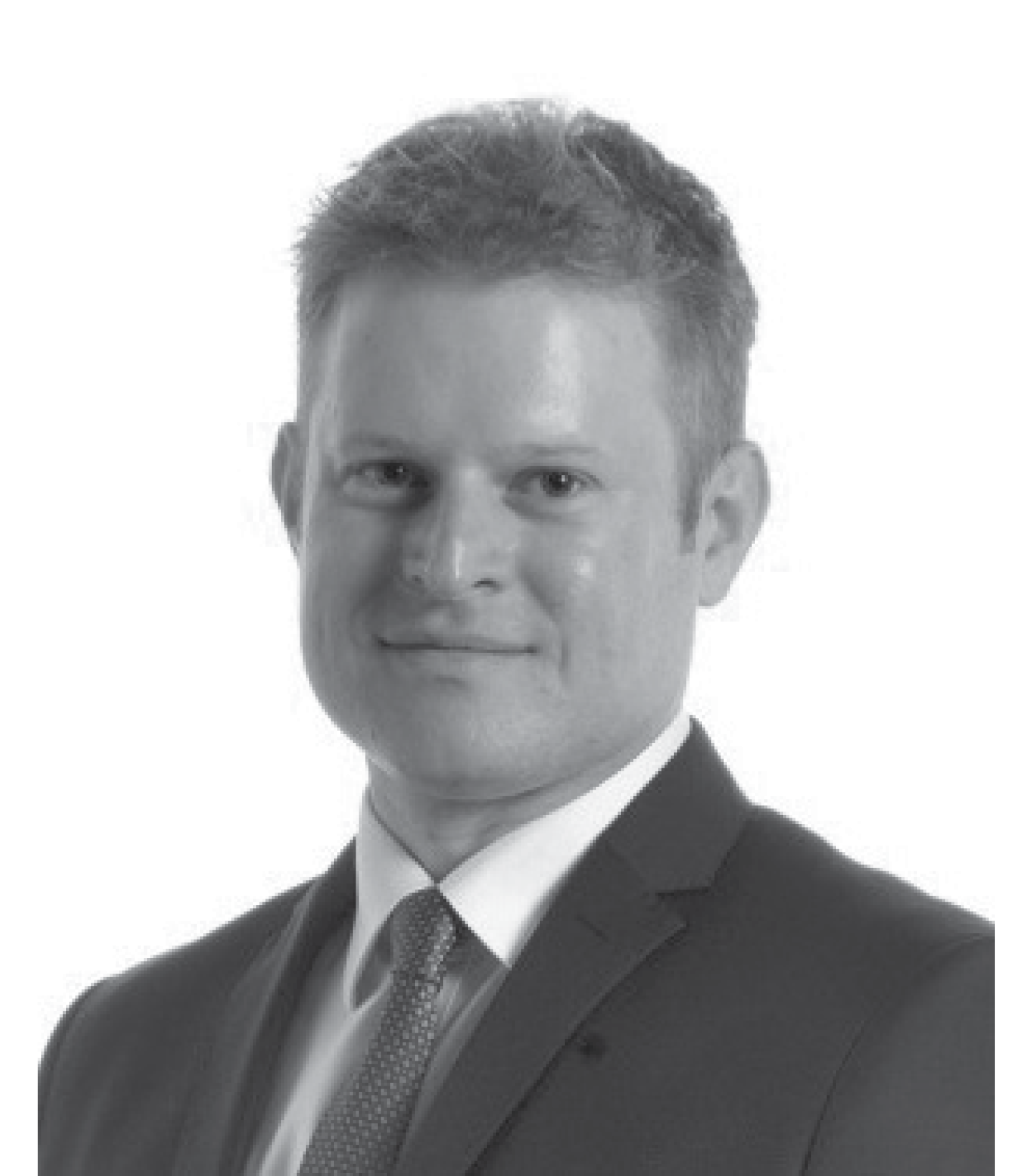
Philipp Wörz, Fund Manager
PSG Asset Management
A globally integrated investment process – different by design. At PSG Asset Management, we have been investing in global equities since 2006. Our global process serves the offshore component of our local funds and our stand-alone global funds. Constructing a portfolio of one’s best ideas can be a challenging task, even in the relatively small local market such as the JSE, and even more so globally.

“ A globally integrated investment process – different by design ”
Global equities – Beware the rearview mirror
A globally integrated investment process – different by design
At PSG Asset Management, we have been investing in global equities since 2006. Our global process serves the offshore component of our local funds and our stand-alone global funds. Constructing a portfolio of one’s best ideas can be a challenging task, even in the relatively small local market such as the JSE, and even more so globally. Our 3M (moat, management, margin of safety) investment process assists us in filtering the large global universe down to our buylists. In its simplest form, it means we are looking to invest in companies whose inherent qualities are temporarily underappreciated by the market, we take a long-term view, and we wait for the investment thesis to play out until we can no longer satisfy ourselves with a margin of safety.
With global stock markets trading near record highs, some of the questions investors are grappling with today are whether to stick with what’s been working over the long term, or whether to change direction.
Give me some tech… and US
As John highlights in his article Only the start of an anticipated outperformance cycle from our differentiated approach, people are prone to extrapolating their most recent experiences, and investors are no different. Ever since the Global Financial Crisis, the place to be has been the US equity market and US tech stocks specifically.
Over the past 10 years to 31 December 2021, US stocks, as represented by the S&P 500 Index, delivered a total return of 362% while investors in the Nasdaq gained a whopping 576%. Contrast this to the MSCI World Index total return of 250% and emerging markets’ measly 76%, you may think you are wasting your time with anything but American.
The past three years have been no different. As seen in the chart below, the US market has returned 100% since the end of 2018, its strongest three-year performance this millennium, and outperformed global stocks outside of the United States by a factor of 2.1 times. Investors in markets such as Hong Kong and Brazil lost money during this period, when measured in US dollar.
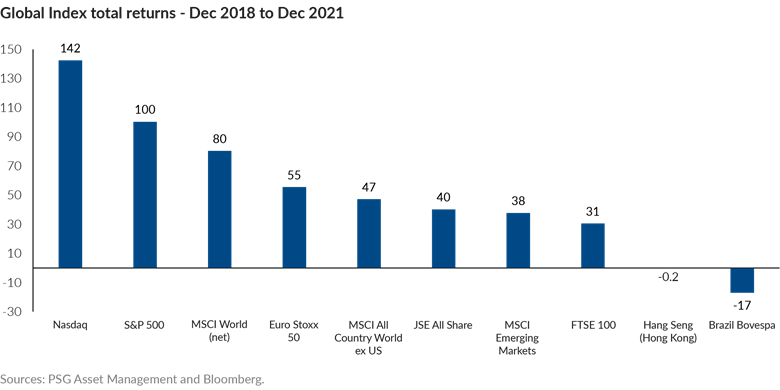
We have written extensively about the extremes in markets and similarities to the dotcom bubble of the late 1990s. While one may argue that it is different today in that the companies driving markets to record highs are amongst the best globally, we can’t escape the fact that global indices are dominated by large cap US stocks and valuations are at extremes when compared to history.
Companies based in the United States accounted for 69% of the MSCI World Index at the end of December compared to 60% five years ago, while the weights of the information technology and communication services sectors increased from 18% to 32%.
The S&P 500 Index is the best proxy for US stocks represented in the MSCI World Index and passive global portfolios. The chart below shows the price to sales ratio of the S&P 500 and the S&P 500 Technology Indices, lately even surpassing frothy ‘dotcom’ levels. There are 75 companies trading above 10 times sales in the S&P 500, and 87 companies when measured on an enterprise value (EV) to sales basis.
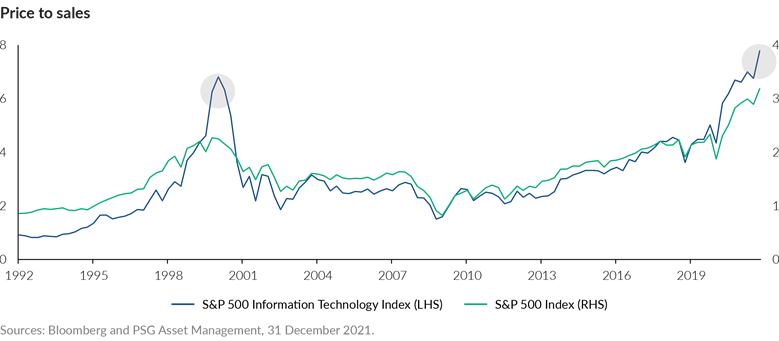
But what does this mean, and why should one pay attention? Valuations, after all, seem to have mattered little in predicting future outcomes recently
Given the long-term dominance of large cap technology and other mega caps, investors in global indices are taking an ever-increasing bet that the winners of the previous decade will continue dominating markets in the future.
As seen in the graph below, the S&P 500 and MSCI World Indices have a high concentration in large, highly valued long duration growth companies that have been strong beneficiaries of low and declining interest rates, accelerated technology adoption due to Covid-19, and investor demand for growth in a growth starved world.
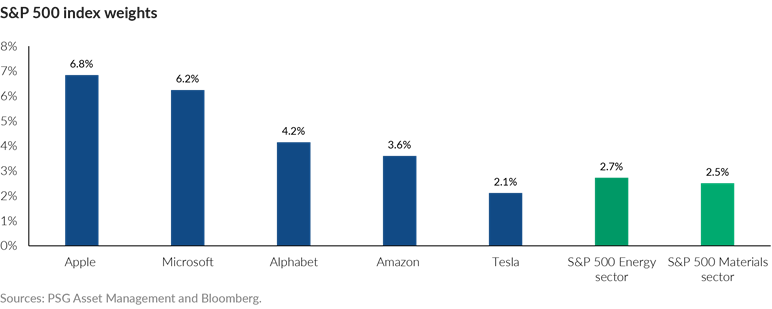
In contrast, sectors which underperformed over the past decade barely feature in the index. Sectors such as energy, materials and financials would materially benefit from a pick-up in growth, inflation and interest rates.
Market positioning suggests investors expect a continuation of the past and are not factoring in an even marginal regime change away from what has worked so well previously. Moving into a more inflationary world (after decades of disinflation) would likely have profound implications for investors and their portfolios.
If large parts of the US market are expensive, should investors throw in the towel and sit in cash?
While markets are trading near record high levels with valuations extended relative to history, one may be forgiven for wanting to sit in cash on the sidelines. However, given the extremities across markets and the ongoing Covid uncertainties, large parts of the global investment universe remain out of favour. In our opinion, for investors to generate satisfactory long-term returns, a highly differentiated, active approach is called for.
Great opportunities in an otherwise expensive market
Justin’s article, Barbarians at the Gate: JSE mid-caps on the shopping list, alludes to the value that private buyers are seeing in South African mid-cap stocks, and these remain an outstanding opportunity in a global context. Despite the funds’ strong performance over the past 18 months, the stocks in our funds largely remain out of favour, have not been beneficiaries of the drivers behind the strong US and large cap growth rally, and are underpinned by attractive fundamentals relative to their own history. Even after the strong showing in 2021, sectors such as energy are merely valued in line with their lacklustre long-term history.
While we do not attempt to predict the future (even if we could, it is futile to predict the market’s response with any degree of accuracy), some of today’s market conditions remind us of the period around the turn of the millennium.
We see parallels to the early 2000s
As shown in the chart below, back in the early 2000s, a concentrated and generally expensive market corrected without dragging everything else down with it. Investors that were willing to invest away from what worked best in the late 1990s were rewarded handsomely.
A topical example illustrating these market dynamics of the late 1990s with similarities to today is the case study below contrasting Microsoft and South African Breweries in the late 1990s and Anheuser-Busch InBev in recent years. For the example below we use SAB, as ABI only became an entity in the early 2000s.
Comparing experiences in SAB and Microsoft
‘Old-economy’ businesses like SAB, under pressure from weak emerging market currencies at the time, vastly underperformed tech darlings such as Microsoft in the lead-up to the bursting of the tech bubble. Microsoft’s share price peaked in December 1999, as seen in the graph below, and in the subsequent 12 months lost 65% of its value and took 16 years to regain its former high, while investors in stocks such as SAB were left relatively unscathed. As investors started to appreciate its strategy and emerging markets returned to growth by the mid-2000s, SAB’s share price made up its previous underperformance.
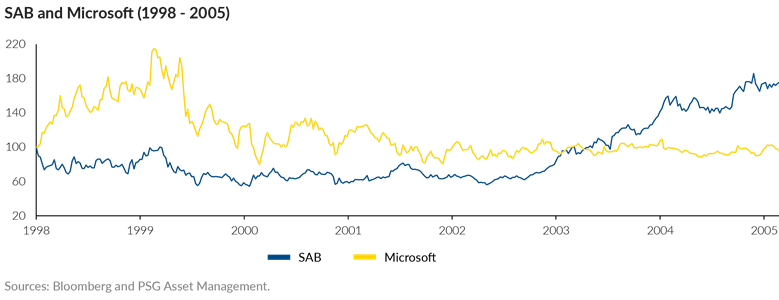
A high valuation around the turn of the century proved too strong a headwind to Microsoft’s share price over the subsequent years and many investors declared the company a ‘has-been’ a decade later. Its low valuation in 2011 and 2012, at a time when Microsoft was embarking on its transition to a subscription-based business model, set investors up for better times ahead. (Microsoft was one of PSG’s top holdings from 2012 to 2017).
Microsoft returned 1500% (32% annual compound return) over the 10 years to 31 December 2021.
Contrast this to Anheuser-Busch’s total return of only 29% (2.5% per annum) over the same period, and you will not be surprised that investors are in love with the former and dislike the latter.
As the graph below shows, the current picture looks strikingly similar to the late 1990s experience with ABI investors losing 36% of their investment since December 2016, compared to Microsoft’s 482% gain.
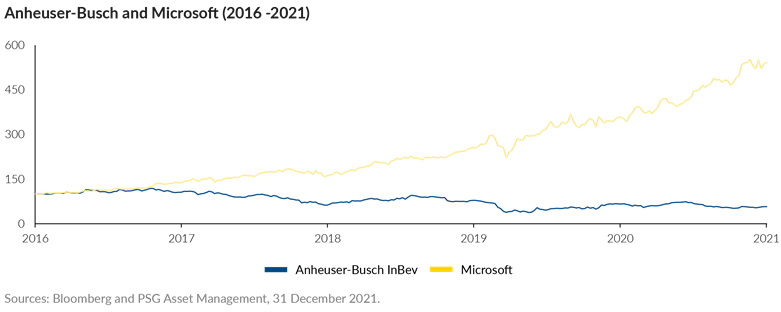
Investment returns from equities are largely a function of earnings and the multiple investors are willing to pay per unit of earnings (sales, EBITDA, profits). The graph below shows the enterprise value (EV) to sales and EV/EBITDA ratios for the respective companies.
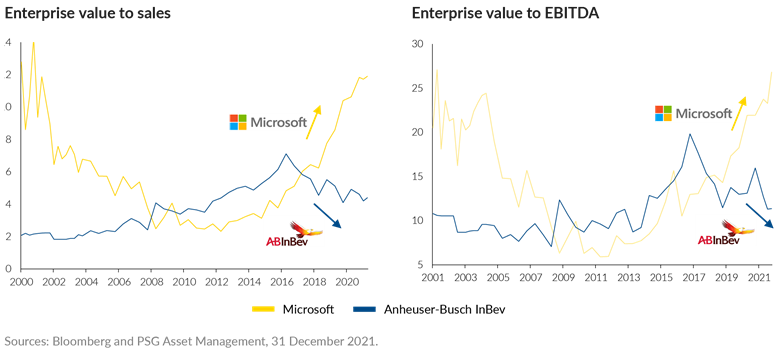
Microsoft investors were paying between 2 and 3 times sales and 6 and 7 times EBITDA in the early part of the previous decade, prior to Microsoft’s business model transition getting proper traction, which then culminated in substantial sales and profit growth in subsequent years. Consequently, growth-loving investors, in a growth starved world, bid up the share to roughly 12 times sales and 27 times EBITDA towards the end of last year, valuation levels last seen in the early 2000s.
Investors in Anheuser-Busch, on the other hand, had high hopes for the company upon consummation of the merger with SABMiller in 2016. Elevated debt levels taken on to fund the deal, emerging market currency and macro concerns, coupled with Covid-19-related headwinds in its high margin ‘on-premise’ channel, all impacting profitability, were amongst the reasons for the markets’ fading love affair with ABI and the disappointing returns since.
As seen in the graph below, ABI’s earnings per share declined over the past five years while Microsoft’s compounded by 26% per annum. These divergent performances are reflected in the forward price to earnings (PE) multiples the stocks are currently valued at, as the following graph shows.
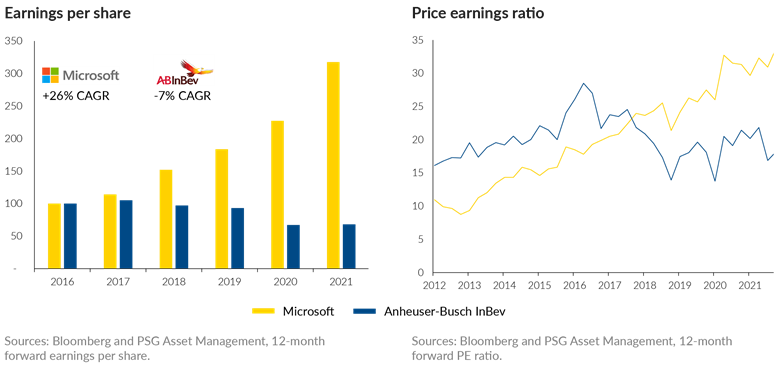
A recovery from Covid-19, its market-leading scale, strong global brands, demographically advantaged emerging market exposure and vastly strengthened balance sheet are some of the reasons ABI investors should expect better times ahead. Microsoft is an amazing company which, in our view, possesses one of the strongest moats in our investment universe. Lofty valuations and expectations that are likely to decline in the years ahead, coupled with slowing earnings growth, are generally a recipe for weaker returns.
The opposite applies to companies trading on low valuations and expectations on below-normal levels of activity at a time when fundamentals are improving.
We think ABI and many of our other portfolio holdings fit the bill and should deliver the goods even in an environment when the popularity of other parts of the market inevitably declines.
The future looks bright
The graph below shows the valuations of some of the large companies dominating global indices, contrasted to some of our largest global holdings.
In an otherwise expensive market, our companies are cheap in absolute terms and relative to their own histories, yet their prospects are improving.
Our global portfolios can be characterised as follows:
- Shares where exceptional quality and growth potential are currently hidden, misunderstood or just ignored by the market. Examples include AB InBev, Prudential Plc, Asahi, Liberty Global and Discovery.
- Basic materials shares such as Glencore and Mosaic (fertiliser), shipping equities, energy and precious metals with constrained supply characteristics.
- Global opportunities in neglected markets such as the UK and Japan.
- The PE ratio of the equities in the PSG Global Equity and PSG Global Flexible Funds of approximately 12 times at the end of December 2021 compares favourably to the MSCI World’s 22.7 times.
At a time when fundamentals should start to increasingly matter again, we think the future of our holdings looks bright. We do not think the same can be said for many of the winners of the past. Extrapolation feels comfortable, until it doesn’t.
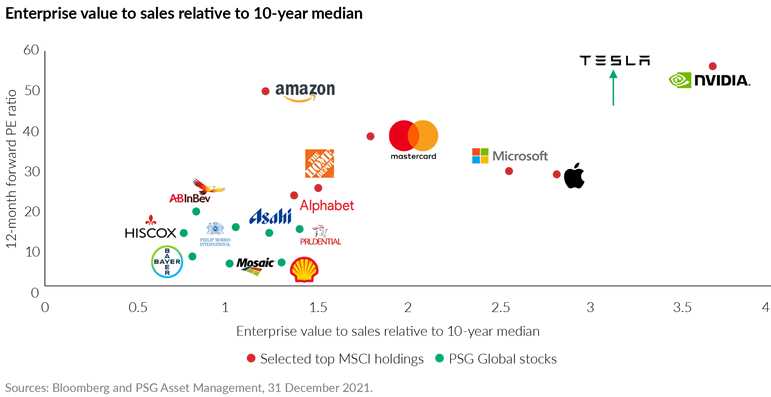
PSG Asset Management is a wholly owned subsidiary of PSG Konsult Group.
Recommended news

Welcome to the latest edition of the Angles & Perspectives
In this edition, we debate why it is important that fund managers differentiate themselves, and then explore how our funds deliver on this imperative. In the first article, Fund Manager John Gilchrist outlines how our 3M philosophy empowers us to deliver long-term outperformance to our clients. Next, Fund Manager Justin Floor finds validation for our views in the recent flurry of interest in mid-cap companies on the JSE. Lastly, Fund Manager Philipp Wörz argues that despite the perception of global markets being expensive, opportunities remain for selective investors using a differentiated approach.
Read more
Introduction - Angles & Perspectives Q4 2021
Investors often resort to mental shortcuts and rules of thumb to speed up decision-making, and tend to extrapolate the recent environment into the future. This encourages a binary outlook (value vs growth, e-commerce vs bricks and mortar) and, as investors pile into what has worked in the past, markets can be driven to extremes. Taking a view that is different from the consensus outlook can be challenging and may seem foolhardy, especially if anomalous market behaviour persists longer than expected. However, this behaviour also creates opportunities for patient investors who are willing to look beyond such oversimplifications and question prevailing narratives. We would also argue that this approach is essential to assuring long-term outperformance.
Read more
Only the start of an anticipated outperformance cycle from our differentiated approach - Angles & Perspectives
Fund managers need to approach the world differently from competitors to deliver outperformance in the highly competitive world of investing – they need to both think and act in a differentiated manner. Behavioural biases and business pressures make truly independent thinking and positioning in portfolios extremely rare.
Read more
Barbarians at the gate: JSE mid-caps on the shopping list - Angles & Perspectives
It is becoming increasingly apparent that there is something valuable hidden on the JSE. The last while has seen a notable surge in activity from private buyers signalling that they see opportunity in JSE-listed mid-cap companies. Private equity, industry players (particularly foreign companies) and even some management teams are taking listed companies off public markets. This zeal and optimism contrasts with the prevailing sentiment we are still observing on the JSE: many smaller, domestic-oriented companies trade below their reasonable fundamental value and pessimism and disinterest continue to prevail.
Read more
The Edge, 3 Howick Close
Tyger Waterfront
Bellville
7530
Stay Informed
Sign up for our newsletters and receive information on finance.







